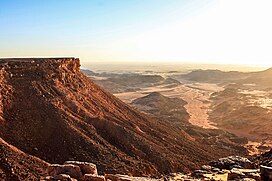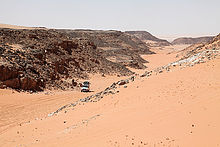Gilf Kebir
| Gilf Kebir | |
|---|---|
 View from the top of Gilf Kebir overlooking Wadi Sura | |
| Highest point | |
| Elevation | 1,014 to 1,016 m (3,327 to 3,333 ft) |
| Coordinates | 23°26′29″N25°50′23″E/ 23.44139°N 25.83972°E |
| Geography | |
| Country | Egypt |
Gilf Kebir(جلف كبير) (var.Gilf al-Kebir,Jilf al Kabir,Gilf Kebir Plateau) is aplateauin theNew Valley Governorateof the remote southwest corner ofEgypt,and southeastLibya.Its name translates as "the Great Barrier". This 7,770 km2(3,000 sq mi)sandstoneplateau, roughly the size ofPuerto Rico,rises 300 m (980 ft) from theLibyan Desertfloor. It is the true heart of theGilf Kebir National Park.
The name Gilf Kebir was given to the plateau byPrince Kamal el Dine Husseinin 1925, as it had no local name.[1]It is known for its rugged beauty, remoteness, geological interest, and the dramatic cliff paintings-pictographsand rock carvings-petroglyphswhich depict an earlier era of abundant animal life and human habitation.
Geography and climate
[edit]TheUweinatmountain rangeat the very south of the plateau extends from Egypt intoLibyaandSudan.
Wadis
[edit]The plateau is crisscrossed byWadis(dry, seasonal riverbeds). These include:
- Wadi Hamraوادي حمرا
- Wadi Akhdarوادى الاخضر
- Wadi Bakhtوادى بخت
- Wadi Dayiqوادى الضيق
- Wadi Firaqوادى فراق
- Wadi Gazayirوادى الجزائر
- Wadi Maftuhوادى مفتوح
- Wadi Mashiوادى ماشى
- Wadi Suraوادي صورة
- Wadi Wassaوادى واسع
- Wadi Abd el-Malikوادي عبد المالك
Climate
[edit]Gilf Kebir Plateau lies in the heart of the eastern part of the vastSahara Desert,and, thus, gets some of the most extreme climates on Earth. This is the driest place on the planet, not only because the area is totally rainless (the annual average rainfall amount hardly reaches 0.1 mm) but also because thegeological aridity index/dryness ratiois over 200, which means that the solar energy received at the ground evaporates 200 times the amount of precipitation received.[2]Rainfall may fall every twenty years in Gilf Kebir.
| Climate data for Gilf Kebir Plateau | |||||||||||||
|---|---|---|---|---|---|---|---|---|---|---|---|---|---|
| Month | Jan | Feb | Mar | Apr | May | Jun | Jul | Aug | Sep | Oct | Nov | Dec | Year |
| Mean daily maximum °C (°F) | 20.8 (69.4) |
23.6 (74.5) |
27.8 (82.0) |
33.8 (92.8) |
36.6 (97.9) |
38.3 (100.9) |
38.7 (101.7) |
38.6 (101.5) |
37.2 (99.0) |
32.3 (90.1) |
26.3 (79.3) |
22.1 (71.8) |
31.3 (88.4) |
| Mean daily minimum °C (°F) | 7.7 (45.9) |
10 (50) |
12.4 (54.3) |
18.4 (65.1) |
22.2 (72.0) |
24.9 (76.8) |
26.1 (79.0) |
26.3 (79.3) |
24.2 (75.6) |
19.2 (66.6) |
13.2 (55.8) |
8.7 (47.7) |
17.8 (64.0) |
| Source:Storm247.com[3] | |||||||||||||
History
[edit]Petroglyphs
[edit]
The Gilf Kebir is known for its prehistoricNeolithicpetroglyphs
- Rock engravings in the upper part ofwadi Hamra.
- Magharet el Kantarain the southern Gilf Kebir contains only one known rock art site, a cave discovered by Shaw & party in 1936.
- Wadi Sura in the southwestern Gilf Kebir: the "Cave of Swimmers",discovered by the Hungarian CountLászló Almásy(The English Patient), plus many other paintings nearby.
- In January 2003,ZerzuraExpeditions and Jacopo Foggini independently discovered a major new rock art site in the Western Gilf Kebir (Foggini-Mestekawi Cave).
- The North-western half of the Gilf Kebir aside from Wadi Sura has only a few scattered engravings, of an apparently very ancient age.
- Karkur Talh and Karkur Murr: major eastern valleys of theUweinatcontain one of the richest concentrations of rock art in the wholeSahara.
- Western Uweinat: Shelters under the huge granite boulders in the western Uweinat contain numerous paintings, including the famous sites of Ain Doua.
- Jebel Arkenu,Jebel Kissu & Yerguehda Hill, the lesser granite massifs around Uweinat have many smaller sites.
Saharanrock arthas been found to resemble the art of Nile valleys.The Saharan area was wetteruntil mid-Holoceneor about 4000 BC, when the monsoon retreated southwards, forcing humans to migrate. Some retreated eastward to the Nile valley, taking with them their beliefs and influencing Egyptian art.[4][5][6]
20th century exploration
[edit]
The hills of the Gilf Kebir were first seen from a distance by European explorers in 1910 - with W. J. Harding-King in 1910 and 1911, and Ball and Lieutenant Moore in 1918. The high southern part of the plateau was sighted for the first time by Prince Kamal el Dine Hussein in 1925, and on another expedition, in the following year, he fixed the eastern escarpment of the plateau and first realised the true size of the plateau. In 1930 an expedition headed byRalph Alger Bagnoldfollowed the same route. In the winter of 1930-1, P. A. Clayton surveyed some of the areas.
The western side of the Gilf Kebir was explored in 1932 by the Clayton-Almásy Expedition, headed by Sir Robert East Clayton andCount László E. Almásy,and accompanied byPatrick A. Clayton,Squadron Leader H. W. G. J. Penderel,three Arabian car drivers and a cook. The expedition explored the area byGypsy Mothplane, by car, and on foot.
1933 Patrick Clayton and Ladislaus Almasy discovered theAqaba-Pass,the only way up Gilf Kebir from the southern plains i.e. from wadi Sura.[7]
WWII archeology
[edit]The plateau was the site for various British logistical operations during theSecond World War,and due to the extremely dry conditions and lack of population, remains of this occupation are often found intact. A large airbase, including huge navigation arrows laid out in army petrol cans, can still be seen at theEight Bells Hillsspot in the southeast of Gilf Kebir.
It was also the site of the 2007 discovery of a bag that had been lost in theSecond World Warby a dispatch rider (Alec Ross) of theLong Range Desert Group,part of theBritish Army.This contained the rider's personal letters and photographs and had been well preserved.[8]
Literary setting
[edit]The Gilf Kebir is the setting for part ofMichael Ondaatje's novelThe English Patient. It also plays an important role in Paul Sussman'sThe Hidden Oasis.
See also
[edit]References
[edit]- ^F. J. R. R., "A Reconnaissance of the Gilf Kebir by the Late Sir Robert Clayton East Clayton" and P. A. Clayton, "The Western Side of the Gilf Kebir"Geographical Journal81, 249-254 and 254-259, (1933)
- ^Richardson, Dan (2003).Egypt.Rough Guides. p.550.ISBN9781843530503.
- ^"Weather for Gilf Kebir Plateau, Egypt".Storm247.com. Archived fromthe originalon 24 December 2013.Retrieved22 June2013.
- ^Jean-Loïc Le Quellec and Pauline and Philippe de Flers (2006)."Prehistoric swimmers in the Sahara."Arts & Culture46-61.
- ^Julien d'Huy (2009)."New evidence for a closeness between the Abu Ra´s shelter (Eastern Sahara) and Egyptian beliefs."Sahara20: 125-126 and Julien d'Huy and Jean-Loïc Le Quellec (2009)
- ^Julien d'Huy and Jean-Loïc Le Quellec (2009)"From the Sahara to the Nile: the low representation of dangerous animals in the rock art of the Libyan desert could be linked to the fear of their animation",or[1]Archived2011-08-11 at theWayback Machine,translation by Geoffrey Kolbe from"Du Sahara au Nil. La faible représentation d'animaux dangereux dans l'art rupestre du désert Libyque pourrait être lié à la crainte de leur représentation."Cahiers de l'AARS13: 85-98, or[2].
- ^Exploration and mapping of Gilf Kebirretrieved 16 April 2020
- ^"WWII Army Bag Is Found In Desert".The BBC.The British Broadcasting Company.Retrieved12 January2023.
External links
[edit]- Legends haunt remote nomad's land,Matthew Davis, BBC. 25 September 2008.
- 'WWII Army Bag is found in Desert'
- Libyan Rock Art Documentation Project
- google map
- Gilf Kebir - Cave of Swimmers

